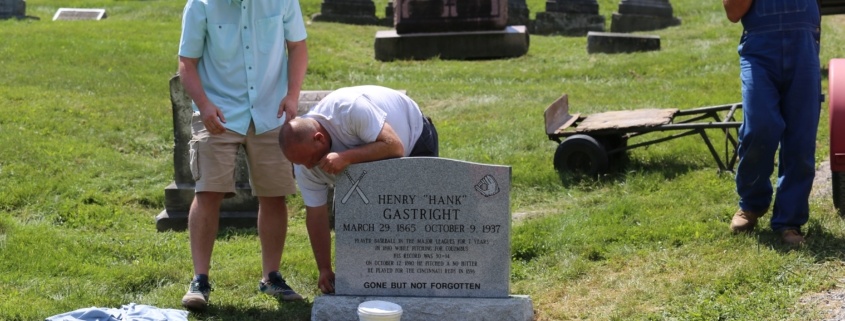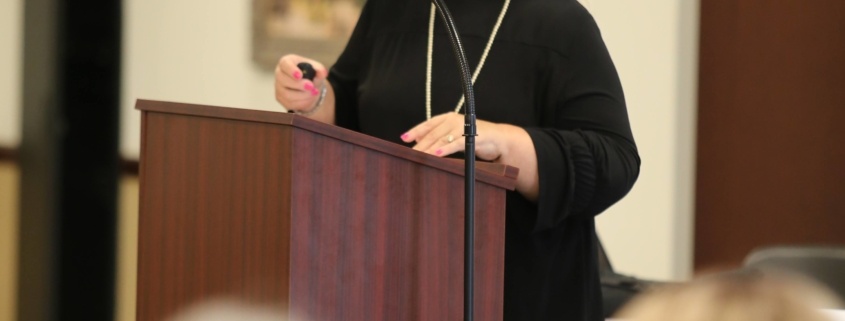Part 1: Cathedral’s Chapel window recalls the First Eucharistic Congress in the U.S.
Stephen Enzweiler, Cathedral Historian
Part 1 in a series
Sunny afternoons in the Blessed Sacrament Chapel are quiet times of whispering candles, prayerful pilgrims and streaming sunlight. Frank Duveneck’s murals gaze down through the silence as colored light splashes across the warm marble and stone columns. Five stained-glass windows in the chapel all tell stories along the theme of the Holy Eucharist — of offerings and prefigurement, celebrations and ritual set in glass upon which the faithful can contemplate and pray. Two windows tell stories from scripture, two contrast the Jewish seder meal and the first Corpus Christi feast celebrated in 1247. But one stained-glass window is different from all the rest.
On the western wall of the chapel is a window that depicts a procession of people with a priest in golden vestments carrying a monstrance. They all move in unison toward an elevated altar upon which an open Eucharistic throne of exposition awaits. At first glance, one might think the scene is a typical Corpus Christi procession such as parishes conduct each June. But this window isn’t about a Corpus Christi procession — it’s about a more profound event.
The window is titled the “First Eucharistic Congress in the United States of America” and it commemorates the first gathering of clergy in the United States who met in 1895 at Catholic University of America in Washington D.C. to bear witness to the real presence of Jesus Christ in the Eucharist. Bishop Camillus P. Maes, third Bishop of Covington, played a leading role in organizing the Congress and served as its Secretary and presiding officer. The gathering was seen by the American prelature as essential to spreading the devotion of the real presence in the Eucharist, and it had the personal blessing of Pope Leo XIII. It was attended by more than 250 priests, bishops and archbishops, including the Vatican’s Francesco Cardinal Satolli and His Excellency James Cardinal Gibbons, Archbishop of Baltimore.
The window measures 21-feet high at its apex and 9-feet across at its base. In the scene, we see the priest in golden vestments processing amid a large crowd of faithful moving toward an altar beneath stone arches. Servers carry a large processional baldacchino above the priest as crowds of faithful follow behind. In the crowd is a cardinal and several bishops. Behind the baldacchino, a banner of the Virgin Mary can be seen. Three solitary figures in floral garments appear in the lower left corner of the window. One wears spectacles and bows reverently to the passing Eucharist; the other two, of distinctly Germanic appearance, gaze devoutly upon the holy Eucharist. High above, amid floral motifs of fig leaves are the armorial bearings of Pope St. Leo XIII.
The window scene was composed by Bishop Maes himself. In a Dec. 10, 1909 letter to Mayer & Company, the Munich firm that produced the window, he instructed, “The priests carrying the Baldachino as well as those walking in the procession are to be in cassock and surplices; the cardinal in rochet and cape; the Bishops in rochet and mantellata … a temporary altar for benediction to be shown on the porch of McMahon Hall.” In reply to Mayer’s query about whether the Bishop wished to be featured in the window, his reply was simple: “No, I do not want any portraits.”
Yet, Franz Borgia Mayer, the owner and director of Mayer & Company, had his sketch artist, George Daniels, render the Bishop’s face as the priest carrying the monstrance. Mayer and Bishop Maes were close, personal friends, and the window maker was often the recipient of his Apostolic blessings. Franz Mayer knew well of Maes’ deep humility, and he likely took the liberty to include his likeness as a way of honoring his friend for his great accomplishment of the Congress. He also had Daniels sketch in his own likeness and those of two other Mayer directors. Thus, in the window’s lower left-hand corner are these three additional figures (from top to bottom): Director Adolph Rau; Franz Borgia Mayer (owner of Mayer & Company); and Director Wilhelm Werberger as the bowing man wearing glasses.
Despite his earlier instructions, Bishop Maes did not seem to mind the changes. “The design … is original and unique,” he wrote in a letter to Mayer. “It is very acceptable.” History records that none of the Mayer directors attended the actual Congress, and Bishop Maes didn’t carry the monstrance in the actual procession. But for the Bishop, historical accuracy was less important than the deeper catechesis behind the window itself. In his heart, he wished the window might serve future generations in “recalling that the Eucharist is our heavenly food and our spiritual nourishment during our earthly pilgrimage.”
For anyone who knew him in life, to think of Bishop Maes was to think of the Holy Eucharist itself, for it was the treasure of his life, and the spread of its devotion became his lifelong ambition. It is said that to watch his reverence for the Sacrament at Mass had a profound effect on those in attendance. So devoted was he to the Blessed Sacrament that he became widely known among his fellow prelates as the “Bishop of the Blessed Sacrament,” just as Pius X was later called the “Pope of the Blessed Sacrament.”
This devotion to the Holy Eucharist began as a very young boy growing up in Belgium. It was instilled in him by his parents and reinforced by his aunt, a Carmelite nun, and two uncles who were priests. During his seminary years, he learned of the great figures of the Eucharist, especially St. Thomas Aquinas, “the poet of the Eucharist,” and St. Peter Julian Eymard (1811-1868), the Marist priest who founded the Congregation of the Blessed Sacrament and later the Priest’s Eucharistic League in France. “The Eucharist is everything,” Eymard wrote, “because from the Eucharist, everything is.” Notably, Eymard’s later life was dedicated to renewing Eucharistic devotion in 19th-century Europe at a time when religion was declining precipitously in the wake of the French Revolution. It was a decline that spread as a materialistic secularism decorated with non-religious alternatives.
American historian Henry Adams witnessed a similar pattern of decline in the United States. In 1860, he recorded the profound cultural, social and intellectual shifts that had taken place since the time of the American Revolution, most notably the “disappearance of religion.” This decline was recorded in many other histories of the period as a time of growing secularization and deep, materialistic orientation. It is a period we have come to know as the Gilded Age.
One of Europe’s responses to the religious decline came in June 1881 with the first International Eucharistic Congress, held in Lille, France with the theme, “The Eucharist Saves the World.” The initial inspiration behind the idea came from a laywoman — Marie Marthe Baptisine Tamisier (1834–1910) who lobbied the clergy for more than a decade. More Congresses were held regularly throughout Europe, with attendance growing each year to more than 150,000 by 1888.
In the United States, devotion to the Blessed Sacrament was seen by clergy as the key to reviving religious devotion. By 1890, the effort to hold a Eucharistic Congress in the United States had been bantered about, but without any action. The “Associato Adoratorium,” under the leadership of Father Bede Maler, O.S.B. of Indianapolis had made little headway among clergy. Realizing something more was needed, Maler turned to his friend, the Bishop of Covington.
On the Feast of St. Thomas Aquinas, March 7, 1894, Bishop Maes met with five priests in his house on Eighth Street in Covington, one of whom was Father Maler. In the Bishop’s front parlor, the “Priests Eucharistic League of America” was formally founded. The following year, Maes was named “Protector of the Priests’ Eucharistic League” for life. The formation of the League accelerated interest among clergy nationwide, generating a greater reverence toward the Holy Eucharist. Within the year, Maes and his fellow bishops began making plans to hold the First Eucharistic Congress in the United States.
Bishop Maes knew from the start the effect such a congress would have, and we can see its effects in the historical record. In 1884, the Catholic population in the Diocese of Covington was about 40,000 with 52 parishes and roughly 800 children enrolled in schools. By 1903, it had grown to over 54,000 Catholics and 78 parishes with 7,137 children enrolled. New churches and schools were being constructed along with the establishment of seven new academies and the formation of new Catholic societies. More broadly, during this period Americans erected most of the country’s largest churches and religious monuments during a growing Gothic Revival movement, producing a vast wealth of religious paintings, sculptures and works of religious art.
Bishop Maes didn’t even begin thinking about creating the Eucharistic Congress window until late in 1908. Perhaps it was because he began feeling his years advancing and wished to leave his flock something of lasting importance. The window we see today is not as much a record of an event that happened on an eastern campus in some distant autumn as it is a message for our present age. It is a window that reaches out to us across time and speaks of a Eucharistic revival that began long ago as the American Church’s response to what was then considered a religious decline in America. Now a century later, another Eucharistic revival is underway with similar purpose, and we can thank our third bishop for showing us the way.
Coming up next: Part 2 — “Roots of 19th Century religious decline ran deep.”
Image: Original George Daniels sketch of the First Eucharistic Congress window. (Copyright Mayer’sche Hofkunstanstalt GmbH/Mayer of Munich) The completed window, which features the likeness of Bishop Camillus Paul Maes, third bishop of the Diocese of Covington, and depicts the first Eucharistic Congress, is visible within the Cathedral Basilica of the Assumption in Covington, Ky.






